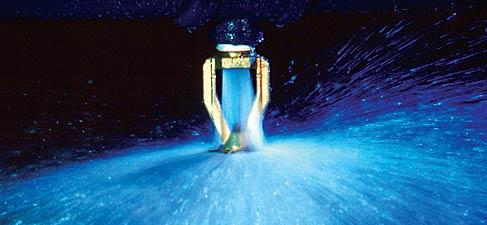

An automatic sprinkler system is intended to detect, control and extinguish a fire, and warn the occupants of occurrence of fire. The installation comprises fire pumps, water storage tanks, control valve sets, sprinkler heads, flow switches, pressure switches, pipe work and valves. The system operates automatically without human intervention.
Each sprinkler head contains a glass bulb or a fusible link. The bulb contains a liquid and a quantity of vapour. The liquid expands under the influence of heat as do the fusible link heads. When the temperature reaches a certain level – typically at 68 Degree Centigrade – it will expand the liquid and break the bulb or fusible link, which in turn releases water directly onto the seat of the fire.
The hot gases from a fire will make the sprinkler operate. A fire creates a narrow plume of hot air and gasses that rise to the ceiling and spread out. These hot gasses activate the sprinkler head at the correct temperature.

Fire sprinkler systems are extensively used worldwide, with over 40 million sprinkler heads fitted each year. In buildings completely protected by fire sprinkler systems, over 96% of fires were controlled by fire sprinklers alone.
Sprinkler have become by far the most widely used and most reliable automatic means of fire protection. Sprinkler systems automatically detect fire, transmit an alarm as a result of water flow and suppress or extinguish the fire. They are located in places where people cannot always be present and operate only as needed in the immediate vicinity of the fire. Because of the care given to design, construction and assembly, and because of the rigid approval tests required, the reliability of conventional sprinkler system is unequalled.
Time is a critical factor in firefighting situation. Automatic sprinklers give firefighting efforts a big jump start on the fire. A building fire generally starts small. However, with sufficient fuel to feed it, the amount of heat, flame and smoke can increase to such a degree, that manual firefighting can be severely hindered, if not totally ineffective.
Sprinklers on the other hand, can detect and control fire effectively to minimize property loss.
Dynapro is an authority on sprinkler design, installation, commissioning, operation and maintenance of the Automatic Sprinkler systems. The applicable & recommended code is NFPA 13 which states that since a fire originating from an unsprinklered area can overpower the capabilities of an existing sprinkler system, it is stipulated that sprinkler must be installed in most areas of the building.
Dynapro recommends sprinkler systems to be installed as per HYDRACULIC Calculation Method stipulated by NFPA and Factory Mutual (FM) standards.